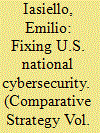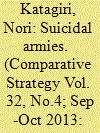|
|
|
Sort Order |
|
|
|
Items / Page
|
|
|
|
|
|
|
| Srl | Item |
| 1 |
ID:
123436


|
|
|
|
|
| Publication |
2013.
|
| Summary/Abstract |
In 2011, the White House and the Department of Defense released strategies for how the United States will approach cyberspace both from an offensive and defensive perspective. Cybersecurity has long been America's Achilles' heel where public and private networks are consistently exploited by criminals, hacktivists, and espionage actors stealing financial data, intellectual property, and sensitive information. The U.S. government has failed to instill an effective national-level cybersecurity apparatus. In order to better position itself defensively, the U.S. government needs to reposition its federal agencies to better capitalize on their capabilities and authorities to address this twenty-first century threat.
|
|
|
|
|
|
|
|
|
|
|
|
|
|
|
|
| 2 |
ID:
123437


|
|
|
|
|
| Publication |
2013.
|
| Summary/Abstract |
It is possible that Iran has covertly acquired a very small number of nuclear weapons and that these have been tested by North Korea. There are an increasing number of reports to this effect going back to 2007 when the London Daily Telegraph reported that with North Korean help Iran could obtain a "low-grade device-less than half a kiloton-within 12 months." According to The New York Times concerning the 2013 North Korean nuclear test, a senior Obama administration official concluded that "it's very possible that the North Koreans are testing for two countries." A.Q. Kahn proliferated detailed technical information not only on the original Chinese CHIC-4 nuclear weapons design but also on a smaller version of the design tested by Pakistan in 1998. If Iran has covertly acquired nuclear weapons, they are likely to be very few in number and low yield. There may still be time to prevent the development by Iran of an extensive nuclear weapons capability but the continuation of the current ineffective diplomacy will not do it.
|
|
|
|
|
|
|
|
|
|
|
|
|
|
|
|
| 3 |
ID:
123439


|
|
|
|
|
| Publication |
2013.
|
| Summary/Abstract |
This article calls for an expansion in the study of Asian geopolitics beyond the Indo-Pacific axis. China's geostrategic rise and that of Asia's other main powers are phenomena that bear multiple maritime and continental manifestations. Insofar as Asia's powers meet in different regions, the "primary" Indo-Pacific theater cannot be isolated from developments in Central, South, Southeast, Northeast Asia, the northwestern Pacific, or the Arctic. By conceptualizing seapower and landpower as an interactive dyad in geostrategy and zooming in on the maritime and continental directions of China, India, and Russia, this article depicts Asia as an increasingly interdependent geopolitical whole.
|
|
|
|
|
|
|
|
|
|
|
|
|
|
|
|
| 4 |
ID:
123440


|
|
|
|
|
| Publication |
2013.
|
| Summary/Abstract |
Why do rebel groups often fight like an army despite the fact that they keep losing most of the time? I examine seven possible answers and find that insurgent forces are likely to use conventional war strategy and be "suicidal" when they receive material aid from outsiders to build up armed forces and fight on terrain that supports large movements, without knowing that such a strategy does not always work, while strong states make interventions to impose their own method of fighting. This finding has important implications for the analysis of asymmetric war, counterinsurgency, and international security.
|
|
|
|
|
|
|
|
|
|
|
|
|
|
|
|
| 5 |
ID:
123438


|
|
|
|
|
| Publication |
2013.
|
| Summary/Abstract |
For more than six decades, the geopolitics of South Asia have been shaped by a symbiotic and triangular relationship involving India, Pakistan, and China. A succession of interstate conflicts has created two fundamental and enduring security structures, one rooted in India's partition and subsequent Indo-Pakistan wars (the "1947 structure") and the other in a persistent and often antagonistic Sino-Indian rivalry, including a border conflict in 1962 (the "1962 structure"). During the Cold War, exogenous powers, including the United States and Soviet Union, sought to use or manipulate these structures to advance their political objectives. In the long term, however, the 1962 structure is likely to become the dominant security architecture in the region, a trend that can be attributed to China's growing military and economic power, Beijing's increasingly intimate relationship with Islamabad, and the Chinese navy's expanding reach into the Indian Ocean.
|
|
|
|
|
|
|
|
|
|
|
|
|
|
|
|
|
|
|
|
|